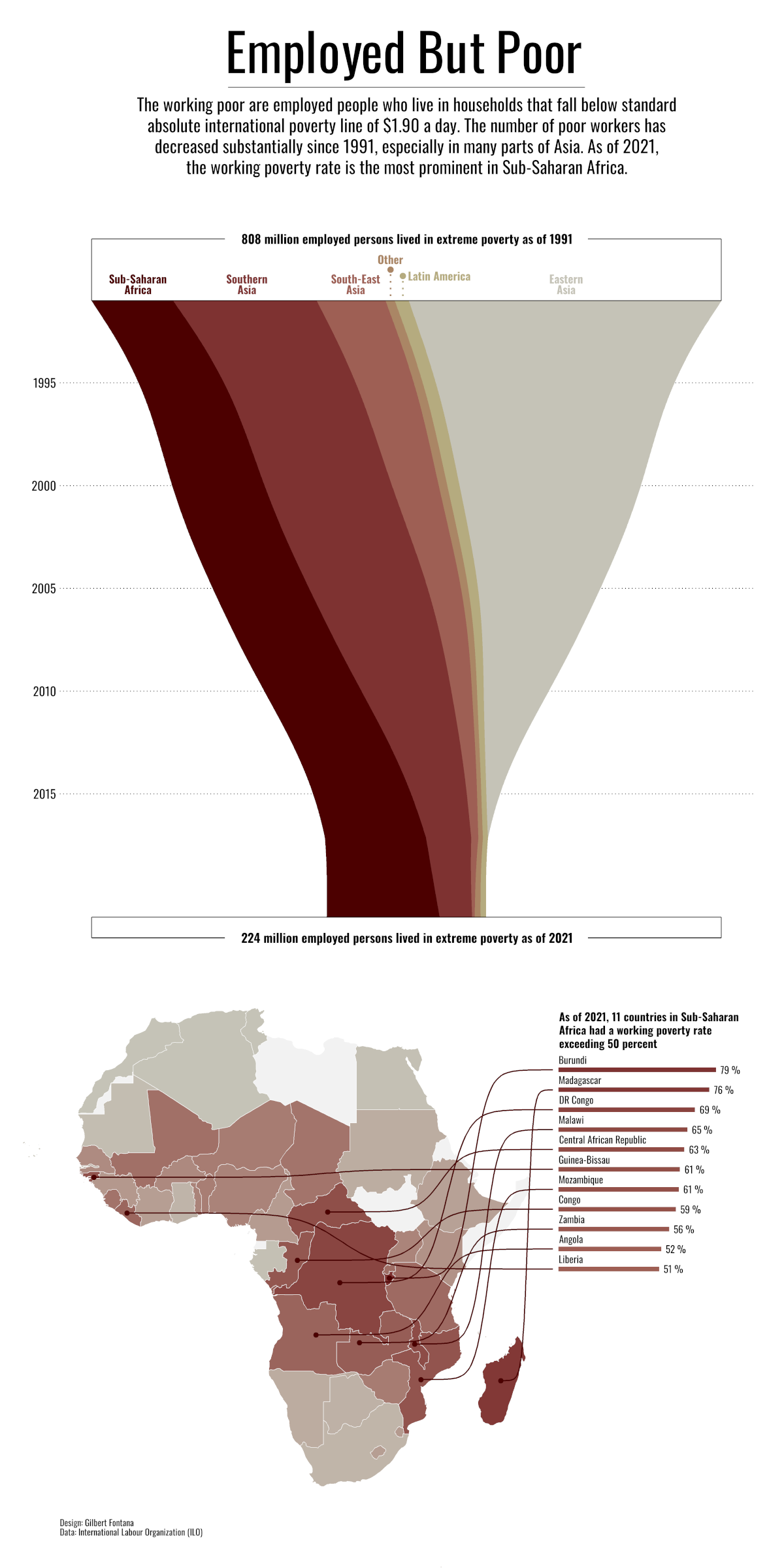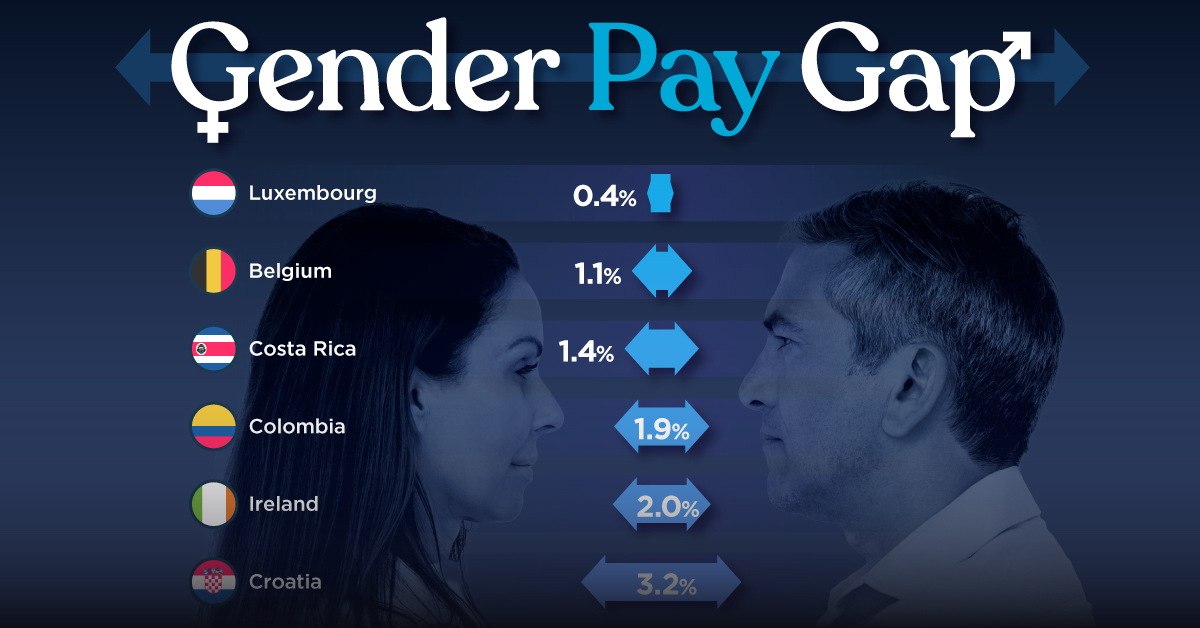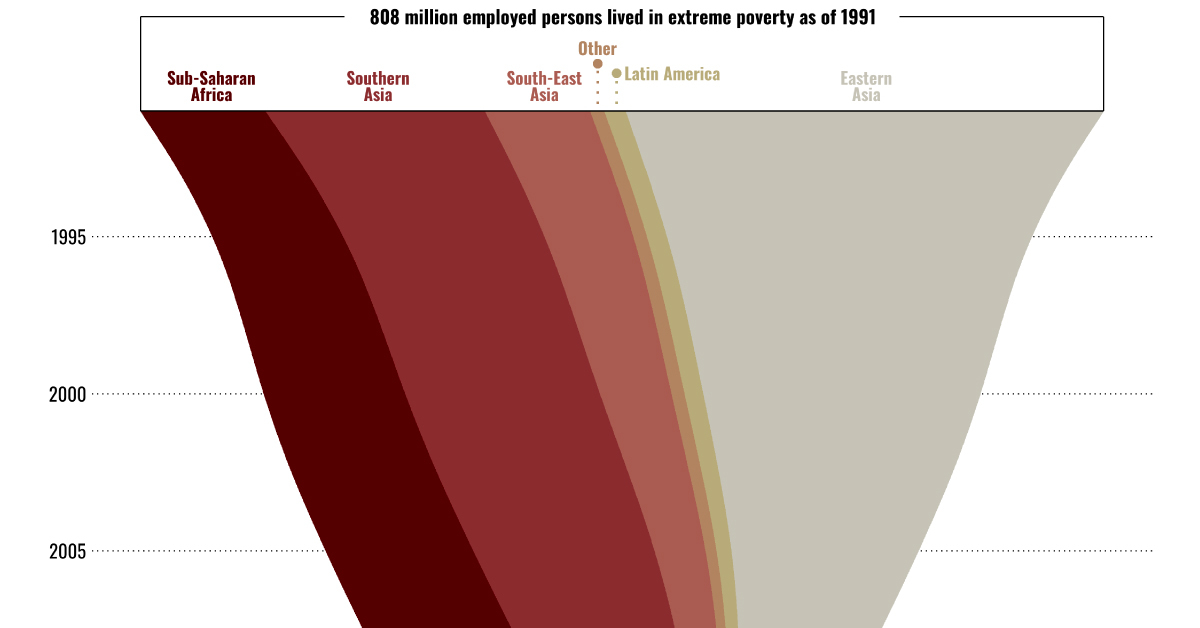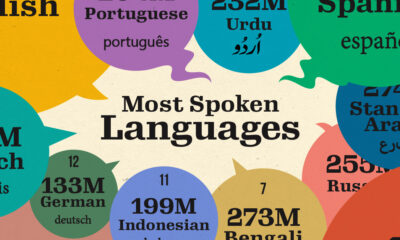Demographics
Charted: The World’s Working Poor, by Country (1991-2021)

Charting Three Decades of the World’s Working Poor
Poverty is often associated with unemployment—however, millions of working people around the world are living in what’s considered to be extreme poverty, or less than $1.90 per day.
Thankfully, the world’s population of poor workers has decreased substantially over the last few decades. But how exactly has it changed since 1991, and where is the majority of the working poor population living today?
This graphic by Gilbert Fontana uses data from the International Labour Organization (ILO) to show the regional breakdown of the world’s working poor, and how this demographic has changed in the last few decades.
From Asia to Africa
In 1991, about 808 million employed people were living in extreme poverty, or nearly 15% of the global population at the time.
As the graphic above shows, a majority of this population lived in Eastern Asia, most notably in China, which was the world’s most populous country until only very recently.
However, thanks to China’s economic reforms, and political reforms like the National “8-7” Poverty Reduction Plan, millions of people in the country were lifted out of poverty.
Today, Sub-Saharan Africa is the region with the world’s highest concentration of working poor. Below, we’ll take a closer look at the region and zoom in on select countries.
Zooming in on Sub-Saharan Africa
As of 2021, 11 of the 49 countries that make up Sub-Saharan Africa had a working poverty rate that made up over half their population.
Here’s a look at these 11 countries, and the percentage of their working population that lives in extreme poverty:
| Rank | Country | Working Poverty Rate (% of total population) |
|---|---|---|
| 1 | 🇧🇮 Burundi | 79% |
| 2 | 🇲🇬 Madagascar | 76% |
| 3 | 🇨🇩 DR Condo | 69% |
| 4 | 🇲🇼 Malawi | 65% |
| 5 | 🇨🇫 Central African Republic | 63% |
| 6 | 🇬🇼 Guinea-Bissau | 61% |
| 7 | 🇲🇿 Mozambique | 61% |
| 8 | 🇨🇬 Congo | 59% |
| 9 | 🇿🇲 Zambia | 56% |
| 10 | 🇦🇴 Angola | 52% |
| 11 | 🇱🇷 Liberia | 51% |
Burundi is first on the list, with 79% of its working population living below the poverty line. One reason for this is the country’s struggling economy—Burundi has the lowest GDP per capita of any country in the world.
Because of the economic conditions in the country, many people struggle to meet their basic needs. For instance, it’s estimated that 40% of urban dwellers in Burundi don’t have access to safe drinking water.
But Burundi is not alone, with other countries like Madagascar and the Democratic Republic of the Congo also having more than two-thirds of their working population in extreme poverty. Which countries will be able to able to lift their people out of poverty next?

This article was published as a part of Visual Capitalist's Creator Program, which features data-driven visuals from some of our favorite Creators around the world.
Demographics
The Smallest Gender Wage Gaps in OECD Countries
Which OECD countries have the smallest gender wage gaps? We look at the 10 countries with gaps lower than the average.

The Smallest Gender Pay Gaps in OECD Countries
This was originally posted on our Voronoi app. Download the app for free on iOS or Android and discover incredible data-driven charts from a variety of trusted sources.
Among the 38 member countries in the Organization for Economic Cooperation and Development (OECD), several have made significant strides in addressing income inequality between men and women.
In this graphic we’ve ranked the OECD countries with the 10 smallest gender pay gaps, using the latest data from the OECD for 2022.
The gender pay gap is calculated as the difference between median full-time earnings for men and women divided by the median full-time earnings of men.
Which Countries Have the Smallest Gender Pay Gaps?
Luxembourg’s gender pay gap is the lowest among OECD members at only 0.4%—well below the OECD average of 11.6%.
| Rank | Country | Percentage Difference in Men's & Women's Full-time Earnings |
|---|---|---|
| 1 | 🇱🇺 Luxembourg | 0.4% |
| 2 | 🇧🇪 Belgium | 1.1% |
| 3 | 🇨🇷 Costa Rica | 1.4% |
| 4 | 🇨🇴 Colombia | 1.9% |
| 5 | 🇮🇪 Ireland | 2.0% |
| 6 | 🇭🇷 Croatia | 3.2% |
| 7 | 🇮🇹 Italy | 3.3% |
| 8 | 🇳🇴 Norway | 4.5% |
| 9 | 🇩🇰 Denmark | 5.8% |
| 10 | 🇵🇹 Portugal | 6.1% |
| OECD Average | 11.6% |
Notably, eight of the top 10 countries with the smallest gender pay gaps are located in Europe, as labor equality laws designed to target gender differences have begun to pay off.
The two other countries that made the list were Costa Rica (1.4%) and Colombia (1.9%), which came in third and fourth place, respectively.
How Did Luxembourg (Nearly) Eliminate its Gender Wage Gap?
Luxembourg’s virtually-non-existent gender wage gap in 2020 can be traced back to its diligent efforts to prioritize equal pay. Since 2016, firms that have not complied with the Labor Code’s equal pay laws have been subjected to penalizing fines ranging from €251 to €25,000.
Higher female education rates also contribute to the diminishing pay gap, with Luxembourg tied for first in the educational attainment rankings of the World Economic Forum’s Global Gender Gap Index Report for 2023.
See More Graphics about Demographics and Money
While these 10 countries are well below the OECD’s average gender pay gap of 11.6%, many OECD member countries including the U.S. are significantly above the average. To see the full list of the top 10 OECD countries with the largest gender pay gaps, check out this visualization.
-

 Real Estate2 weeks ago
Real Estate2 weeks agoVisualizing America’s Shortage of Affordable Homes
-

 Technology1 week ago
Technology1 week agoRanked: Semiconductor Companies by Industry Revenue Share
-

 Money1 week ago
Money1 week agoWhich States Have the Highest Minimum Wage in America?
-

 Real Estate1 week ago
Real Estate1 week agoRanked: The Most Valuable Housing Markets in America
-

 Business2 weeks ago
Business2 weeks agoCharted: Big Four Market Share by S&P 500 Audits
-

 AI2 weeks ago
AI2 weeks agoThe Stock Performance of U.S. Chipmakers So Far in 2024
-

 Misc2 weeks ago
Misc2 weeks agoAlmost Every EV Stock is Down After Q1 2024
-

 Money2 weeks ago
Money2 weeks agoWhere Does One U.S. Tax Dollar Go?















